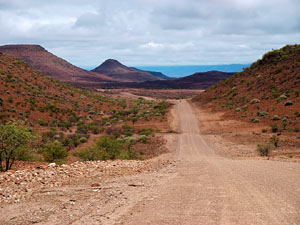
A PHOTO SAFARI TO NAMIBIA
uk photographer david baron does exotic namibia.

A PHOTO SAFARI TO NAMIBIA uk photographer david baron does exotic namibia. |
 Spectacular Namibian scenery Spectacular Namibian scenery
| ||||||||
|
INTRODUCTION: This is David Baron's report on his field trip to Namibia in February 2008. David is an active member of the UK Photo Safari Group and is happy to share photographs of his latest adventure taken with his E-3. This is the first of a range of articles provided by active members of the rapidly expanding UK Photo Safari Group. At the bottom of the article is a SLIDESHOW that illustrates some of the images David brought back from Namibia. The PhotoSafari concept is based in the UK and abroad and invites all Olympus owners everywhere to join the fun. You can register your interest or find out about forthcoming events by contacting Brian Mosley here.
PHOTOGRAPHERS NARRATIVE: The trip as planned: The trip to Namibia in February (at the end of the rainy season !) was a motor cycle-based tour over 3000 kms on the country's dirt roads. We left Windhoek and went south-west to the edge of the Namib desert where we embarked on a guided tour of the Sossusvlei Sand Dunes which are some of the highest on earth. We then moved on west across the desert to the Atlantic coast at Swakopmund, a charming German-style small town. We then went north for 100 kms to the Cape Cross Seal Reserve home of the largest colony of Cape Fur Seals in the southern hemisphere. There are up to 100000 gathered to feed on the rich fish supplies from the Antarctic Benguela Current which closes the coast in this area. The road then went east and north through the Brandberg Mountains to Opuwo. This is a typical small African township about an hour from the Angolan border. We then returned south back to Windhoek taking in rock carvings and a game lodge. The arrival: When we arrived it was very hot (38C) even on the plane at 6000 feet. The landscape was very harsh though not unattractive being shades of sand and browns and very dry. On the second day the rainy season
arrived and over the next ten days the whole area had fifteen inches of rain, the most they had seen in 30 years, in fact it didn't rain last year at all ! This did help to keep some of the dust down but we had to watch out for flash flooding and washed-out roads, we also had to make a couple of detours to avoid impassible rivers.
So, on to the photo opportunities and logistics. Massive landscapes, massive skyscapes, intense lighting and great visibility. Few opportunities to photo the locals and when it arose the usual cost was about £1 or a beer.
The E3 was used mainly with the ZD14-54mm lens and was carried in a padded waist bag. During the two weeks it got covered in dust and for one day at least was thoroughly wet from the bag being soaked during a massive
downpour whilst riding. It's not easy carrying a camera whilst motor cycling and as I found out even more difficult whilst riding an off-road bike on rutted dirt roads.
The nature of the trip meant that there was little time to stop and the whole exercise of removing your helmet and gloves whilst hot was a problem. I often used the E-3 flip-out screen and found that I could operate the camera satisfactorily even with my gloves on and I think the results speak for themselves. The camera never missed a beat (unlike the operator!) in over 1500 shots. The ZD14-54mm was excellent as was the ZD50-200 which, although used sparingly, produced amazing results. As I only purchased the camera and lenses three weeks before I left the learning curve has been quite steep but I can confidently say that any problems experienced have been down to the user.
My photographic style is mainly biased towards producing images for a video show so composition is not always my highest priority. I'm sure you'll forgive me.
If you are interested in Namibia or would like more information about some of the places I visited and photographed and are now showcased either above or in the slideshow, follow these links: WINDHOEK: here. SWAKOPMUND: here. OPUWO: here.
I hope you enjoy the following slideshow Brian Mosley has put together for me. Next time I plan an exotic trip there will be more time to arrange for UK Safari Group members to join me in some amazing photo opportunities!
SLIDESHOW: Click centre box to begin.
|